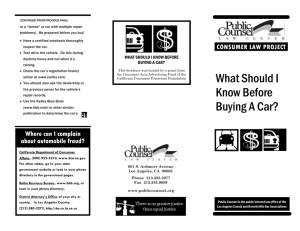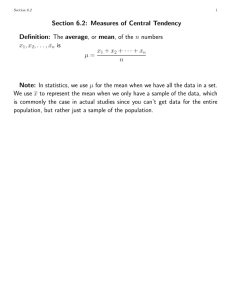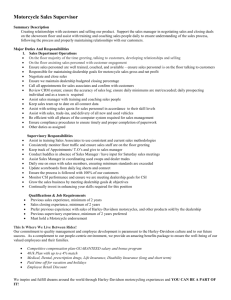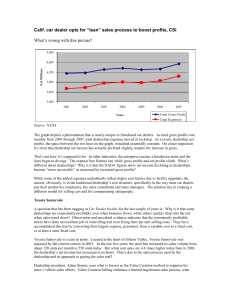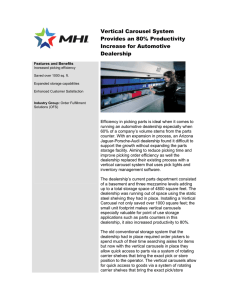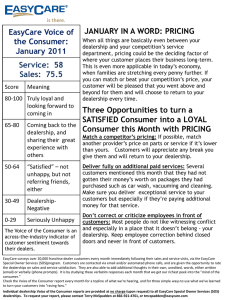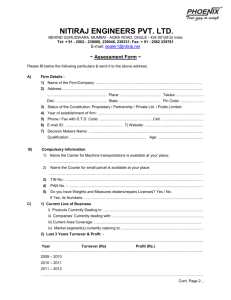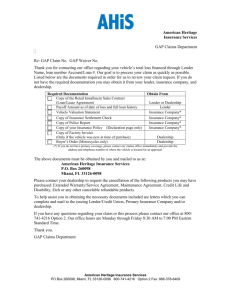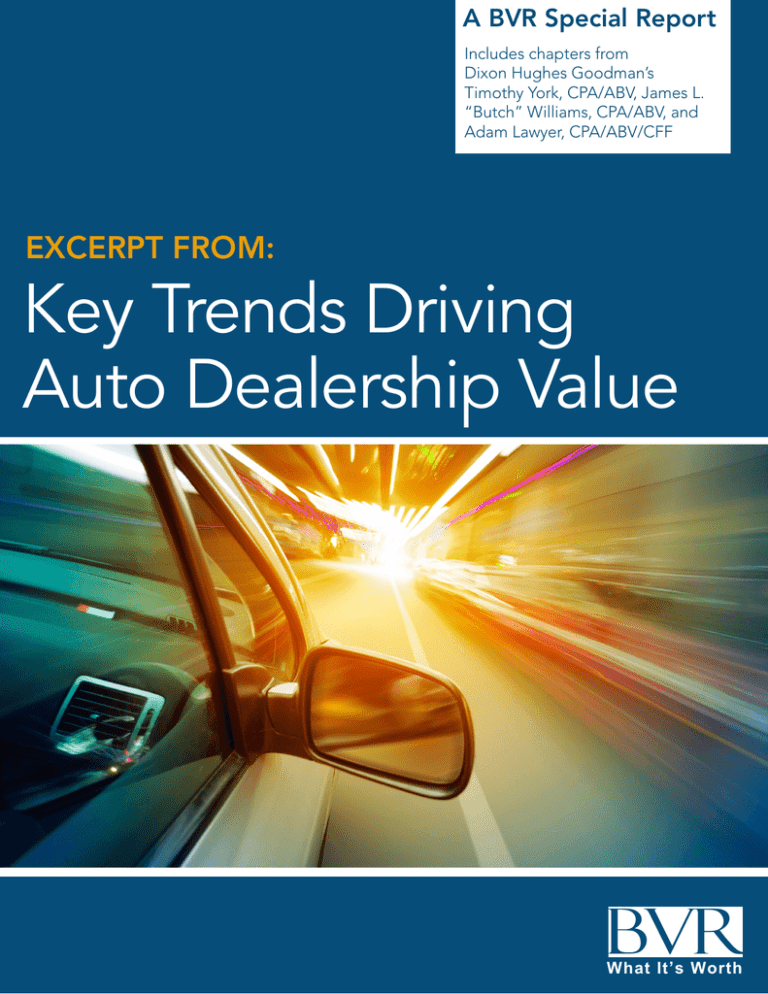
A BVR Special Report
Includes chapters from
Dixon Hughes Goodman’s
Timothy York, CPA/ABV, James L.
“Butch” Williams, CPA/ABV, and
Adam Lawyer, CPA/ABV/CFF
EXCERPT FROM:
Key Trends Driving
Auto Dealership Value
BVR
What It’s Worth
Key Trends Driving
Auto Dealership Value
A BVR SPECIAL REPORT
1000 SW Broadway, Suite 1200, Portland, OR 97205
(503) 291-7963 • www.bvresources.com
Special thanks to Timothy W. York, CPA/ABV, for his expert guidance
and contributions to this special report.
Copyright © 2013 by Business Valuation Resources, LLC (BVR). All rights reserved.
Printed in the United States of America.
No part of this publication may be reproduced, stored in a retrieval system or transmitted in any form or by any
means, electronic, mechanical, photocopying, recording, scanning or otherwise, except as permitted under Sections
107 or 108 of the 1976 United States Copyright Act, without either the prior written permission of the Publisher or
authorization through payment of the appropriate per copy fee to the Publisher. Requests for permission should be
addressed to the Permissions Department, Business Valuation Resources, LLC, 1000 SW Broadway St., Suite 1200,
Portland, OR 97205, (503) 291-7963, fax (503) 291-7955.
Information contained in this book has been obtained by Business Valuation Resources from sources believed to
be reliable. However, neither Business Valuation Resources nor its authors guarantee the accuracy or completeness
of any information published herein and neither Business Valuation Resources nor its authors shall be responsible
for any errors, omissions, or damages arising out of use of this information. This work is published with the
understanding that Business Valuation Resources and its authors are supplying information but are not attempting
to render business valuation or other professional services. If such services are required, the assistance of an
appropriate professional should be sought.
Editor: Jan Davis
Publisher: Sarah Andersen
Managing Editor: Janice Prescott
Chair and CEO: David Foster
President: Lucretia Lyons
Vice President of Sales: Lexie Gross
Customer Service Manager: Retta Dodge
ISBN: 978-1-62150-031-5
Library of Congress Control Number: 2013951535
Table of Contents
INTRODUCTION . . . . . . . . . . . . . . . . . . . . . . . . . . . . . . . . . . . . . . . . . . . . . . . . . . . . . . . . . . . . . . . . . . . . 4
SECTION 1. THE CURRENT AUTO DEALERSHIP MARKETS . . . . . . . . . . . . . . . . . . . . . . . . . . . . . . . . 5
1. THE VALUE DRIVERS OF AUTO DEALERSHIPS . . . . . . . . . . . . . . . . . . . . . . . . . . . . . . . . . . . . . . 6
2. WORDS OF WISDOM FROM ONE OF THE NATION’S LARGEST AUTOMOTIVE RETAILERS . . 9
3. DEALERSHIP AND DEALERSHIP GROUP PERFORMANCE TRENDS . . . . . . . . . . . . . . . . . . . . 11
By Alan Haig and Erin Kerrigan
SECTION 2. VALUATION CONSIDERATIONS IN AUTO DEALERSHIPS . . . . . . . . . . . . . . . . . . . . . . . 14
4. REAL ESTATE IS AN IMPORTANT COMPONENT OF AN AUTO DEALERSHIP VALUATION . . . 15
By Adam Lawyer, CPA/ABV/CFF
5. SPECIAL ISSUES TO CONSIDER WHEN VALUING A USED CAR DEALERSHIP . . . . . . . . . . . . 19
By Carl Woodward, CPA
6. LOST PROFITS FOR AUTOMOBILE DEALERSHIPS. . . . . . . . . . . . . . . . . . . . . . . . . . . . . . . . . . . 22
By Timothy W. York, CPA/ABV
SECTION 3. AUTO DEALERSHIP BUY-SELL TRENDS . . . . . . . . . . . . . . . . . . . . . . . . . . . . . . . . . . . . . 35
7. THE CURRENT AUTO DEALER ACQUISITION ENVIRONMENT AND ITS IMPACT ON BLUE
SKY. . . . . . . . . . . . . . . . . . . . . . . . . . . . . . . . . . . . . . . . . . . . . . . . . . . . . . . . . . . . . . . . . . . . . . . . . . 36
By Timothy W. York, CPA/ABV
8. THINKING OF SELLING? A 23-FACTOR CHECKLIST TO HELP YOU MAXIMIZE VALUE . . . . 41
By James L. “Butch” Williams, CPA/ABV
9. DEALERSHIP BUY-SELL ACTIVITY IS INCREASING SHARPLY . . . . . . . . . . . . . . . . . . . . . . . . . 46
By Alan Haig and Erin Kerrigan
10. BUY-SELL TRENDS AND FRANCHISE VALUATION RANGES . . . . . . . . . . . . . . . . . . . . . . . . . 50
By Alan Haig and Erin Kerrigan
11. SUCCESSION PLANNING BUILDS AUTO DEALER VALUE . . . . . . . . . . . . . . . . . . . . . . . . . . . 55
By Loyd H. Rawls
APPENDICES . . . . . . . . . . . . . . . . . . . . . . . . . . . . . . . . . . . . . . . . . . . . . . . . . . . . . . . . . . . . . . . . . . . . . 58
APPENDIX A. PRICING A NEW CAR DEALERSHIP—RULES OF THUMB . . . . . . . . . . . . . . . . . . . 59
APPENDIX B. PRICING A USED CAR DEALERSHIP—RULES OF THUMB . . . . . . . . . . . . . . . . . . 65
APPENDIX C. NEW AND USED CAR DEALERSHIPS: SOURCES OF INFORMATION . . . . . . . . . 68
Introduction
Valuations by their very nature are fluid; therefore it can be difficult to describe “the value” of an
auto dealership. Despite the challenges, this publication serves to accomplish two main objectives:
(1) to leave a lasting record of key points to consider when performing a valuation of an automobile
dealership; and (2) to discuss the current market in which a dealership operates.
On these pages, you’ll read thoughts from numerous experts that deal with dealerships and valuation issues daily. These individuals include accountants, brokers, merger and acquisition executives,
former dealership employees and owners, and other consultants and advisors. Combined, these
experts point you in the direction to “hit the mark” when valuing a dealership. What better resources
for this publication than professionals who daily advise on buy/sells, executives who lead their
groups on acquisition strategy, professionals whose financial livelihoods depend on transactions
in this space, and others whose combined experience with dealerships is approaching 200 years.
The authors also educate the readers on issues such as the real estate considerations of auto dealerships, the used and independent dealership area, and the need for succession planning, which
may create the need for valuations more than any other driver.
Auto dealers can also find useful information in these chapters, such as how to build value in a
dealership for future sale and what the larger retailers are thinking in terms of future acquisitions.
We hope this report is helpful—in whole or in part—as you strive to address the complex world of
automobile dealership valuations.
Sincerely,
Timothy W. York, CPA/ABV
Editor
4
www.bvresources.com
6. Lost Profits for Automobile Dealerships1
By Timothy W. York, CPA/ABV
Lost profits pertaining to automobile dealerships can at times include a wide variety of businesses
underneath the “dealership” umbrella. Typically, most cases concern traditional automobile dealerships, although some others might additionally focus on motor sports, “power” sports, and heavy
truck areas.2 This chapter discusses primarily automobile dealerships because they are most likely
to incur damages from lost profits. Although there are differences among the various auto dealerships, this chapter will assist the financial expert in identifying certain key areas that are also
likely to be present in the motor sports, power sports, and heavy truck arenas.
A wide variety of circumstances can evolve into disputes in the dealership arena. Cases can involve
the following, among others:
• Natural disasters (insurance claims quantification, etc.);
• Business interruption and damaging events;
• Highway construction and/or easement changes;
• Unawarded or terminated dealership franchises;
• Management shortfalls or inattentiveness;
• Labor strikes;
• Lack of proper product;
1
2
22
Excerpted from the forthcoming Comprehensive Guide to Lost Profits and Other Commercial Damages for Experts and Attorneys, Third
Edition.
Motor sports generally include motorcycles and related equipment, and most power sports dealers sell and service watercraft
of many sizes. Heavy truck dealerships include those in a variety of classes, often separated by the size of the trucks.
www.bvresources.com
6. Lost Profits for Automobile Dealerships
• Governmental or regulatory changes;
• Employee theft;
• New real estate or business developments; and
• Loss of large employer.
Frequent disputes arise within this country’s approximately 18,000 new vehicle dealerships in the
context of their franchise agreements and related manufacturer relationships. Economic damages
can and do occur to the over 25,000 used vehicle dealerships in the United States, but as an initial
matter, this discussion will focus on lost profits damages as they relate to new vehicle dealerships.
Franchise Relationships
Franchise Agreements
New automobile dealerships operate by approval from a manufacturer. The manufacturer provides
the dealer with vehicles, parts and accessories, training, sales materials, and other services for a
certain brand. Such relationships between the dealership and the manufacturer are dictated by
terms located in a franchise dealer sales and service agreement. Some areas that these agreements
typically cover include:
• Location;
• Management;
• Ownership of dealership;
• Product allocation;
• Product ownership;
• Facility requirements and/or improvements;
• Standards of customer service;
• Regulatory requirements;
• Dealer evaluation;
• Restrictions on marketability of franchise;
• Rights of first refusal on ability to sell;
• Capital requirements;
• Systems’ coordination; and
• Termination.
www.bvresources.com
23
Key Trends Driving Auto Dealership Value
Some manufacturers have multiple brands. General Motors, for instance, holds the Chevrolet,
Cadillac, Buick, and GMC brands. Not only will some dealerships have the right to sell multiple
brands under the same manufacturer umbrella, but some will also have equivalent rights to sell
and service brands from multiple manufacturers. Dealerships often acquire franchises of various
types to help diversify their holdings and products from which consumers choose. A dealer with
a franchise to sell vehicles from a domestic manufacturer (e.g., Ford) might also desire a franchise
from an import manufacturer (Honda). This could be a sound financial decision for a dealer, but at
times, it can create friction among the affected manufacturers because they each dictate terms with
the dealer and compete for items such as highway frontage, number of parking spaces, remodeled
facilities, customer waiting areas, etc.
Franchise Laws
The first franchise agreement between automobile dealers and manufacturers was created in 1931 by
the National Automobile Dealers Association (NADA) from its desire to protect dealers’ investments
in franchises. Since then, these contracts naturally evolved into complex agreements setting forth the
parties’ understanding, including details regarding the areas listed above, among others. Due to the
concern over the large capital investments in acquiring or building dealerships and sustaining their
operations, states have enacted regulations to protect dealers. These franchise laws serve to protect
and enhance a dealer’s contractual rights and eliminate sudden and erratic changes to the values of
these rights. State franchise laws share common characteristics, including provisions that prevent
a manufacturer from declining to renew a franchise agreement without reasonable cause; create
mileage restrictions within which dealers can operate (e.g., dealers of similar brands cannot operate
within a 10-mile radius of one another); and protect dealers who attempt to transfer franchises through
transactions with other dealers and dealership groups. These are just a few of the focal points for
these laws, all of which are designed to ensure that a dealer’s investment in the franchise (which can
include massive investments in property aligned with a brand’s image requirements) is protected.
These laws are in place in all 50 states, and resources are available at various state and local dealer
trade associations to assist in understanding the laws that apply in each jurisdiction. Further, many
attorneys specialize in this area and are often “of counsel” for the various dealer trade associations
located in all states and in most large metropolitan areas.
Finally, in 2009, many state legislatures began considering amendments to expand or enhance
these laws, a response to the large number of franchise terminations by GM and Chrysler during
the severe economic downturn that began in 2008.
Franchise Damages
As one might expect, many of the disputes over the dealer’s lost profits involve and include the
franchise agreement. In some of these disputes, the dealer and the manufacturer are the primary
parties. Others may include additional dealers—when, for example, one dealer claims that another
has violated relevant franchise laws.
24
www.bvresources.com
6. Lost Profits for Automobile Dealerships
Lost profits cases involving auto dealerships often include the dealer’s claim that the manufacturer/
franchise partner has violated either the relevant franchise agreement or the applicable franchise
laws. To provide some background for these disputes, automobile manufacturers are continually studying the markets in which a dealership operates and/or wishes to operate. These market
studies typically consider demographics, traffic counts, population growth patterns, and sales
expectations, among other factors. Based on these analyses, manufacturers make strategic decisions to meet their objectives, which often include opening new dealerships in developing areas,
deemphasizing certain other areas, aligning various franchises, or adjusting areas of responsibility
(AORs). The manufacturer’s decision to take any of these four actions would affect existing dealers
in the area and create opportunities for concern and ultimately disputes. There are other potential
areas in which disagreements may arise, but these are the more common ones observed and are
detailed below.
Examples
A dealer’s AOR or territory, as outlined in the franchise agreement, is often referred to in the
industry as a “point.” Thus, one might say that a certain dealer has the western Birmingham
“point” for a certain franchise. One of the most common causes of a lost profits dispute is when
a manufacturer opens a new point. Based on its market studies, a manufacturer may decide that
its brand underserves a certain geographic area. To make up for this perceived weakness in brand
coverage, the manufacturer awards a new franchise to a dealer who may be completely new to the
area or, in some cases, owns another dealership brand there. While such a decision presumably
complies with the local franchise laws, this point will often lie at the crux of a dispute between
the existing dealer and the manufacturer. Common claims are that the new dealership at the new
point will erode the business and profits of the existing dealership. Lost profits analyses are often
based on the assumption that the new dealer is taking profits away from the existing one, which
should be compensated for its losses.
An additional area of friction arises from the common practice of the manufacturer awarding the
new point for no consideration. The new dealer provides adequate facilities and operations within
the manufacturer’s guidelines, but pays no actual purchase price for the franchise. In many cases,
the existing dealer purchased its franchise from a prior owner, paying significant amounts. Thus
a new dealer who was “given” the franchise in the same point negatively impacts the existing
dealer—which has sizable investments in the franchise and facilities. While this factor may not
be a technical component of a lost profits calculation, it certainly creates the negativity that can
permeate such cases.
In other cases, manufacturers deemphasize certain markets based on their strategic objectives.
This scenario can involve a number of perspectives or alternatives. A common example is when
a manufacturer decides to close a point or a specific brand—for example, Mercury in 2011. Again,
after reviewing market studies, a manufacturer may decide not to renew a franchise agreement.
This decision is most often based on declining performance in the area, changes in demographics,
population, or the perceived future of marketing the manufacturer’s brand in the location. This
www.bvresources.com
25
Key Trends Driving Auto Dealership Value
has occurred more frequently in recent years as domestic manufacturers (GM, Ford, and Chrysler)
try to consolidate their dealer body by reducing underperforming stores, often in less populated,
rural areas. In some cases, the manufacturer will attempt to compensate the dealer for the value
of the terminated franchise. However, based on the number of lost profits cases in this area, many
dealers often feel that the compensation offered for the loss of that franchise is inadequate.
Once again, in 2009, both GM and Chrysler terminated hundreds of points based on the criteria
listed above, as well as numerous financial and performance metrics of the dealerships’ performance. In almost all of those cases, the manufacturers paid almost no compensation for these
terminations, although they reinstated several in the last three years.
This scenario can also come about when manufacturers decide to discontinue entire brands, such
as Chrysler eliminating the Plymouth line in 1999, GM eliminating the Oldsmobile in 2000, and
Ford eliminating Mercury in 2011. The manufacturers attempted to compensate affected dealers
for those massive changes. For example, Chrysler would often award Chrysler, Dodge, and/or Jeep
franchises to dealers that may have been lacking one of those brands. GM and Ford, on the other
hand, chose to pay dealers cash based on self-created formulas. Naturally, many dealers chose
to take the alternative route of the legal system, claiming a lack of adequate compensation, and
numerous lost profits and economic damages cases stemmed from those events.
Other disagreements in the franchise area involve a manufacturer’s goal to properly align its
dealerships in accordance with its branding strategies. The term “channeling” is often used to
describe when a manufacturer aggregates its brands, such as GM’s desire to group GMC Trucks
and Buick brands within one dealership in designated market areas and the actions it took to
achieve this objective. Similarly, for years, Ford wanted to channel the Lincoln brand with Mercury
and Chrysler typically wanted one dealership in each area to hold the Chrysler, Dodge, Jeep, and
Ram franchises. Chrysler’s channeling stemmed from its desire to have “Genesis” stores, a term
it used to indicate a store holding all lines. In some cases, the preferred alignments occur through
natural merger and acquisition activity, but most resulted from either “soft” encouragement by the
manufacturer or stronger persuasion. The manufacturer might also provide financial assistance
and other incentives to encourage buyers and sellers of these franchises to interact and align the
stores according to the desired tracks. Naturally, these exchanges of brands can create concerns
among the existing dealers that are either affected by the channeling changes or not included and
could benefit by such alignments. Such concerns occasionally turn into lost profits engagements
for financial experts.
In more isolated instances, manufacturers will adjust territories or AORs based on a number of
different reasons. Predictably, these adjustments can create strife among parties who perceive the
adjustments to have a negative impact on their franchises and dealerships. Alternatively, some
franchisors could argue that the changes have impacted other dealerships more favorably than
their own. Although these cases occur in more limited instances, they do provide an avenue for
lost profits matters.
26
www.bvresources.com
6. Lost Profits for Automobile Dealerships
Several cases on lost profits include disputes revolving around franchise agreements. Among the
more relevant cases:
• Belleville Toyota, Inc. v. Toyota Motor Sales, U.S.A., Inc., 770 N.E.2d 177, 197 (Ill. 2002);
• Bero Motors, Inc. v. General Motors Corporation, 2007 WL 844899 (Ill. 2007);
• FMS, Inc. v. Volvo Construction Equipment North America, Inc., 2009 U.S. App. LEXIS 4938
(7th Cir. March 4, 2009), rev’ing FMS, Inc. v. Volvo Construction Equipment North America,
Inc., 2007 U.S. Dist. LEXIS 19577 (N.D. Ill. March 20, 2007);
• To-Am Equipment Co. v. Mitsubishi Caterpillar Forklift America Inc., 152 F.3d 658 (7th Cir. 1998);
• Davis v. Forest River, Inc., 2002 WL 764262 (Minn. App. 2002)(unpublished);
• Reeder-Simco GMC, Inc. v. Volvo GM Heavy Truck Corp., 374 F.3d 701 (8th Cir. 2004);
• Fabrication & Truck Equipment, Inc. v. Powell, 195 Or.App 72, 96 P.3d 1251 (Or.App. 2004); and
• Flood Mobile Homes, Inc. v. Liberty Homes, Inc., 203 Wis.2d 270, 551 N.W. 2d 869 (Wis. App.
1996).
Three of these—the To-Am Equipment Co., Davis v. Forest River, and Flood Mobile Homes cases—involved
the termination of the franchise agreements or the relevant relationship contracts. The Bero Motors
case concerned efforts by General Motors to channel its brands. The Belleville Toyota and FMS, Inc.
cases claimed breaches in the franchise agreements due to product allocation, rebranding, and
supply issues. The Reeder-Simco case alleged supposed favoritism in pricing by a manufacturer,
and the Fabrication & Truck Equipment case highlighted issues related to faulty product.
Lost Profits Considerations
One difference between assessing dealerships and other types of businesses in lost profits matters is
that the former may include valuing the franchise agreement itself. Although more traditional lost
profits models may include franchise rights, they may not consider all the facts and circumstances
involved in owning dealerships. These circumstances will include focusing on dealerships that
are not profitable or have not shown the consistent ability to produce profits.
When considering a dealership with historical profit levels or an ability to sustain profits, traditional
models apply when performing lost profits analyses. By contrast, when dealerships lack such an
ability or history, traditional models may not apply to assessing the intangible value arising from
ownership of the franchise agreement. In most cases, however—and regardless of the dealership’s
performance—there will be a baseline value associated with the franchise rights. This is supported
by the recent year’s practice among publicly traded dealership groups to list franchise rights separately on their financial statements.3 As these groups publish more acquisitions and continue to
3
See, e.g., public filings re: AutoNation, Inc. (ticker “AN”); Sonic Automotive, Inc. (SAH); Asbury Automotive Group, Inc. (ABG);
Penske Auto Group, Inc. (PAG); Group 1 Automotive, Inc. (GPI); and Lithia Motors, Inc. (LAD).
www.bvresources.com
27
Key Trends Driving Auto Dealership Value
itemize franchise rights and other intangible assets, there should be more relevant information in
future years on valuing franchise rights.
Again, traditional valuation and damages models may imply that the franchise agreements lack
a specific, discrete value, but in most cases, a baseline value or consideration exists within the
ownership of the agreement. Numerous dealership transactions involve large payments for the
franchise rights, even when the parties expected little or no profits at the existing dealership. These
transactions illustrate the importance of considering franchise rights in an engagement for lost
profits, even when superficially they might appear to have little impact on the matter.
Consideration of this baseline value for the franchise rights most often comes into play when
calculating lost profits for a specific franchise, such as described in some of the scenarios above.
In those cases, one must make sure that the franchise rights’ baseline value is considered, even
when there otherwise appears to be little or no lost profits. For example, in developing a lost
profits calculation, one might calculate $500,000 in damages, when the market repeatedly shows
that comparable franchises change hands for $750,000. Unfortunately, there are no published
studies of franchise rights, but in-depth inquiries and market research can help disclose such
information. The damages expert should make relevant inquiries of the dealer as well as other
dealers in the area, dealers’ association representatives, dealership brokers, representatives of
the manufacturer and any other comparable manufacturers, and attorneys and CPAs who specialize in dealerships.
Understanding the Dealership Business
Complexity of the Business
Many involved in the industry often talk of the intriguing complexity of the dealership business.
While outsiders may perceive the market to involve only selling and servicing automobiles, dealerships can often include five different types of businesses or more under one umbrella. New vehicles are retail sales of new product shipped from the manufacturer, while preowned (or “used”)
vehicles still involve retailing, but also involve a variety of acquisition methods. The servicing of
vehicles caters to a number of different customers, including the manufacturer for warranty work,
the preowned department for engine and internal reconditioning work, and customer retail work.
The parts department must maintain inventories for all brands held, many of which are small and
lower-cost items, so inventory management is a major consideration. Finally, for stores that have
collision centers (also referred to as “body shops”), the customer is most often a large insurance
carrier, so these departments cater to a different type of customer than the rest of the dealership.
In this brief summary description, one can envision a large variety of activities going on within
one dealership, including retailing and wholesale sales, production for service and collision work,
and areas that have no inventories to major process-oriented areas. Thus, when conducting a lost
profits engagement, one must be familiar with how a dealership operates and what specific areas
of the business will become a focus for the engagement.
28
www.bvresources.com
6. Lost Profits for Automobile Dealerships
There are additional complexities to consider when developing calculations for lost profits. Often
dealership performance is most accurately developed by “building up” each of the affected
departments, instead of applying general and overall industry averages. To build up a dealership’s expected performance for these purposes requires detailed departmental data, industry
data, and a basic understanding of the core components of each department’s business. When
starting such an engagement, financial analysts should be sure to acquire the appropriate data
(discussed below) and gain access to dealership personnel or other experts who can help navigate these complex areas.
Significant Considerations
Facilities
In today’s dealership environment, almost all manufacturers have what are known as “image
programs” and related requirements. Most dealerships are involved in ongoing discussions with
manufacturers about the adequacy of their facilities, including the need to: expand for new capacity,
remodel due to the facility’s age, respond to the manufacturer’s desire to include that dealership
within its preferred image, or relocate to a preferred location. This preferred image often includes
the manufacturer’s suggestions and occasional requirements on size, color, shape, appearance,
and other characteristics that will make most of the dealerships that offer a particular brand appear similar. The manufacturers often provide dealers with detailed illustrations to enhance their
position, including supplying data that support increased sales and performance on new and/or
renovated stores. In some cases, manufacturers will apply substantial pressure to dealers to comply
with their desires for the facilities. While these pressures have increased in recent years, so has
the resistance, particularly with a study commissioned by the NADA that is beginning to question the effectiveness and return on investments (ROI) of facility improvements. In more limited
cases, some may even use these facility upgrade requests as leverage in renewing the franchise
agreement, which often occurs every three to five years.
Not surprisingly, the costs of these seemingly continual improvements affect the dealership’s
earnings and cash flows and become a large component to consider in a lost profits matter, as it
would seem unlikely that a dealer would continue indefinitely without a significant expenditure
toward facilities improvement and/or compliance with manufacturer conditions. Further, the lost
profits expert must consider how an upgrade to the manufacturer’s requirements would affect the
dealership because the additional investment could change the dealer’s performance.
Location
It is critical to underscore the importance of location on a dealership’s ability to perform because
location is often deemed to be among the top two or three most important characteristics of a store.
A store located in a very affluent section of a city would logically be more attractive to a high-end
brand, such as Lexus, BMW, or Mercedes, to name a few. Predictably, franchises that provide lowerpriced vehicles may not perform as well in that area. Thus, simply utilizing dealership “averages”
can be deceiving and can produce inaccurate conclusions.
www.bvresources.com
29
Key Trends Driving Auto Dealership Value
Additional considerations beyond simple population and demographic factors include traffic counts
and traffic patterns. A store located in an auto mall would naturally expect to have more traffic than
a store located away from other dealerships. Large retail areas are often attractive to dealerships,
although they are expensive to acquire and dealers often compete with other “big-box” retailers
for such prime real estate.
There are also resources available to determine a dealership’s market penetration. R. L. Polk &
Companies, for example, publishes information regarding the extent to which a dealership sells
vehicles in its own market. (Selected industry and related valuation resources are listed at the end
of this chapter.) Thus one would expect that a dealership with an excellent location for its vehicle
types would sell more than its brand competitors with less envious locations. Prime locations
typically allow for easier access and convenience for customers desiring to have their particular
vehicles serviced. In sum, the location can “drive” much of the consideration for a dealership’s
expected performance and must be a major part of a lost profits determination.
Franchise Type
When compiling data for such a lost profits engagement, the damages expert should spend significant time on understanding and researching data related to specific brands that the dealership
carries. This is important not only for the perceived desirability of the franchise, but also to more
accurately predict its performance “but for” the damaging acts. Quite simply, some vehicle brands
are always attractive and others are not, and it is crucial to understand where the considered franchise fits in that spectrum to develop accurate forecasts in the context of franchise rights issues
(discussed above). In the current economic environment, some franchise types are on the verge
of extinction and there is little or no value in simply holding the franchise, while others garner
millions of dollars solely for the particular franchise rights. Various industry surveys detail the
desirability of franchises and dealer satisfaction in carrying the various brands (see list of selected
resources below).
Addressing this concept is critical to develop accurate assumptions for a lost profits calculation.
When creating models, it is imperative that the financial expert avoid using dealership “averages.” These averages may include high-dollar luxury import dealerships all the way down to
the lower-priced volume vehicle sellers. They also include both domestic brands (GM, Ford, and
Chrysler) as well as imports (Toyota, BMW, Hyundai, Kia, etc.). As one might expect, the average
performance of these franchise types vary dramatically, so focusing on this factor is a must in lost
profits engagements.
Financial and Operational Reporting
Each manufacturer has its own prescribed format for reporting a dealership’s monthly performance.
These “dealer financial statements” are typically several pages long and provide summarized
balance sheet data, general and detailed statement of operational data, and a number of pieces
of operating data. These usually provide an excellent source of data for lost profits calculations,
30
www.bvresources.com
6. Lost Profits for Automobile Dealerships
including detailed data at the department level. In addition, dealerships often use a long list of
industry-specific terms, many of which appear on these financial statements. Acquiring a basic
understanding of these terms is helpful because they provide clarity in interviewing dealership
personnel as well as ease in understanding and interpreting the relevant financial and operating
data. A very brief sampling of these terms includes:
• Back end—another name for fixed operations (parts, service, and body shop) of the
dealership;
• Blue sky—another name for the goodwill or other intangible assets of the dealership;
• Finance chargebacks—the unearned portion of finance income that is repaid to the financial
institution when customers prematurely pay off their loans;
• CSI—Customer Satisfaction Index, a measure of polled data obtained by the manufacturer
to evaluate the dealership’s customer service performance;
• Demo (demonstrator)—a vehicle typically driven by the dealership’s sales personnel and/
or management that is always made available to customers for demonstration purposes;
• DOC—Daily Operating Control Report, an internally produced summary report, prepared
for management that details the dealership’s daily and month-to-date sales, gross profit,
and expense information by department;
• Dueling—a practice of maintaining more than one new vehicle franchise at one common
physical facility (e.g., Toyota and Mazda);
• F & I—finance and insurance;
• Factory—another name for the manufacturer or franchisor (example, Ford, Toyota, etc.);
• Fixed operations—another name for the dealership’s nonvehicle sales operations (e.g., parts,
service, and body shop);
• Floor plan—financial institution financing of vehicle inventory, with each floor plan note
secured by a vehicle;
• Front end—another name for the vehicle sales (new and used) operations of the dealership;
• Holdback—an amount held by the manufacturer that is later remitted to the dealership in
addition to a new vehicle’s purchase price;
• Rebates—inventory-related compensation received from the manufacturer;
• SSI—Service Satisfaction Index; and
• Water—a term used to indicate the inventory cost (usually parts and used vehicles) that is
carried on the financial statements in excess of fair value.
www.bvresources.com
31
Key Trends Driving Auto Dealership Value
Notably, two cases involving automobile dealerships focused on financial and operational reporting. In Gardner v. Little, an acquirer claimed that the seller misrepresented the net worth of
the dealership, raising issues of the appropriate level of due diligence by an acquiring party in
studying the seller’s financial data.4 Fairway Dodge, Inc. v. Decker Dodge, Inc. dealt with the theft of
dealership data by the plaintiff’s former employees, later employed by the defendant.5 In that case,
the alleged theft supported claims not only for the lost profits of the plaintiff/dealership, but also
a diminution of its intangible value.
Relevant Resources
Understanding the Business
Fortunately there are ample data to help financial experts gain a reasonable understanding of the
auto dealership industry. A number of publications address several different facets of a dealership,
including a basic description of operations as well as specific operational considerations and accounting issues. Many of these sources also provide an exhaustive glossary of relevant terms and
reference materials. NADA has an extensive number of publications available. Thomson PPC’s offers
a Guide to Dealerships, and the American Institute of Certified Public Accountants (AICPA) holds
an annual National Automobile Dealership Conference with extensive related resource materials
Due to the auto dealership’s economic prominence, a number of periodicals focus on the industry. These include the weekly Automotive News, as well as the monthly Ward’s Dealer Business and
AutoExec magazines. In addition, numerous Internet-based publications and sites provide tools to
assist the financial expert in a lost profits project. For these and other helpful resources, see the
list at the end of this section.
Financial and Operational Data
Like many industries, the auto dealership area has information providers that deliver timely and
detailed data for use in lost profits matters. As discussed above, the most accurate calculations
utilize industry data that are most similar to the subject dealership.
While data from the publicly traded dealership groups may have limited application to the more
common dispute concerning a privately owned dealership, these sources can still be helpful, depending on the particular engagement and its purpose. As mentioned above, for example, cases
involving the rights to a franchise may now require the separation and particular consideration of
these rights. This is especially true in traditional valuation engagements but, as noted above, can
enter into the lost profits calculations. A study of the publicly traded groups can be useful due to
the numerous pricing multiples that can be derived from their daily stock pricing. Again, while
differences in dealership sizes often limit the usefulness of comparisons, they at least provide
another indicator for use in the engagement.
4
5
32
Gardner v. Little, 755 So.2d. 1273 (Miss. App. 2000).
Fairway Dodge, Inc. v. Decker Dodge, Inc., 191 N.J. 460, 924 A.2d 517 (2007).
www.bvresources.com
6. Lost Profits for Automobile Dealerships
However, the more common lost profits engagements involve a single dealership. Thus, it is imperative that the financial expert acquire the relevant data. Many dealerships throughout the country
participate in what the industry refers to as “20 Groups,” a nice-size grouping (not always of exactly
20 dealerships) of similar type, size, and branded stores that regularly share operating and financial
data from the dealership financial statements. Facilitators often start the groups and lead regular
exchanges of information, including very detailed reports of comparative financial performance.
The level of detail in these reports is quite helpful to lost profits analysts because the typical 20
Group report will provide numerous pages on each department. Such detail naturally allows for
excellent analysis of the subject company’s performance and also provides group averages to help
build expectations of the dealership’s future performance. NADA and NCM Associates are the two
main facilitators of 20 Groups that share sanitized operating and financial information.
Using 20 Group information eliminates the concern over using averages compiled from all dealerships as well as from those that may occupy a wide spectrum of franchise types and sizes. When
performing a lost profits analysis, the financial expert may do well to ask whether the subject
dealership is involved in a 20 Group. Reports that include the specific dealership’s information are
invaluable in providing comparable data and should be acquired whenever available.
Many manufacturers provide constant operating data to their dealers, some distributing information daily. Much of this information relates to sales and how the dealership’s performance may
relate to its peers. However, manufacturers also distribute information on customer satisfaction
related to service and sales, and a more select few provide data comparing their dealerships on
many financial metrics, including detailed operational categories. Many dealerships ignore or
forget these reports, and so a lost profits expert should see whether they receive this information
or encourage dealership personnel to contact the manufacturer’s representative to acquire the data.
Valuation-Related Guidance
Although lost profits calculations differ in many ways from traditional valuation approaches and
methods, at least two general valuation sources may be helpful in a particular lost profits engagement. One is A Dealer Guide to Valuing an Automobile Dealership, published by NADA and updated
periodically. Also, Chapter 20 in the Handbook of Advanced Business Valuation addresses common
issues that arise in valuing a dealership. Much of the commentary in these two publications can
be helpful in a lost profits matter.
What follows is a comprehensive list of the relevant providers and resources to use when valuing
automobile dealerships for lost profits engagements:
National Automobile Dealers Association
www.nada.org
R. L. Polk & Co.
www.polk.com
Ward’s Dealer Business
www.WardsAuto.com
Annual Market Data Book from Automotive News
www.autonews.com/section/datacenter
www.bvresources.com
33
Key Trends Driving Auto Dealership Value
NCM Associates Inc.
www.ncm20.com
Dealer’s Edge
www.dealersedge.com
A Dealer’s Guide to Valuing an Automobile Dealership
www.nada.org
The Handbook of Advanced Business Valuation
www.mcgraw-hill.com
NADA 20 Group Operating & Expense Profiles
www.nada.org
First Research Industry Profiles: Automobile Dealership www.firstresearch.com
The Automobile Dealership Valuation Guide
www.nvst.com/pubs/autodealval-pub.asp
Valuation Resources.com
www.valuationresources.com
General Bibliography
The NADA Story: America’s Resilient Auto Retailer, available at www.nada.org.
NADA Data—New Car Dealerships 2009, www.nada.org.
Automobile Dealerships Industry Profile, by First Research, www.firstresearch.com.
Robert F. Reilly and Robert P. Schweihs, Handbook of Advanced Business Valuation (McGraw-Hill 2000).
Timothy W. York, CPA/ABV, is partner-in-charge, dealer services group, at Dixon Hughes Goodman LLP. He can be reached
at tim.york@dhgllp.com or 205-212-5300.
34
www.bvresources.com
BVR
What It’s Worth
A BVR Special Report
Key Trends Driving
Auto Dealership Value
Key Trends Driving Auto Dealership
Value: A BVR Special Report
After a long lull, auto dealership buy/sell activity is on the rise. With an improving industry landscape, owners need to know how to create more value in their dealerships to get the most when
BVR they are ready to sell, while business appraisers should be prepared for an increased demand for
auto dealership valuation. Key Trends Driving Auto Dealership Value: A BVR Special Report discusses the unique characteristics and considerations important to both owners who are looking to increase and maintain their competitiveness and the valuation professionals who appraise auto dealerships for buy/sell purposes, gift and
estate and expert witness testimony.
What It’s Worth
Highlights of the Special Report include:
•
•
•
•
•
•
•
•
•
Top value drivers in the auto dealership industry
Blue sky multiples and buy-sell trends
Current trends in auto dealership retailing
Real estate considerations when determining the value of an auto dealership
Key issues that arise when valuing an auto dealership
Unique aspects of valuing used car dealerships
A checklist for preparing to sell an auto dealership
Rules of thumb and key sources of auto dealership data
Key sources of oil and gas industry data
Learn more & order online at: www.bvresources.com/publications
If you prefer, please call (503) 291-7963 or fax this page to our secure line: (503) 291-7955
❏
Yes! Please send me Key Trends Driving Auto Dealerships, A BVR Special Report for
$143.10 – a 10% savings! (delivered as a PDF via email)
Name:
Firm:
Address:
Phone:
City,State,Zip:
Fax:
E-mail:
Billing Information:
❏ Visa ❏ Mastercard ❏ AMEX ❏ Check payable to: Business Valuation Resources, LLC
Exp. Date:
Sec. Code:
Credit Card #:
Cardholder Name & Address (if different):
Business Valuation Resources, LLC . 1000 SW Broadway, Suite 1200, Portland, OR 97205 . (503) 291-7963
PRIOR1892

